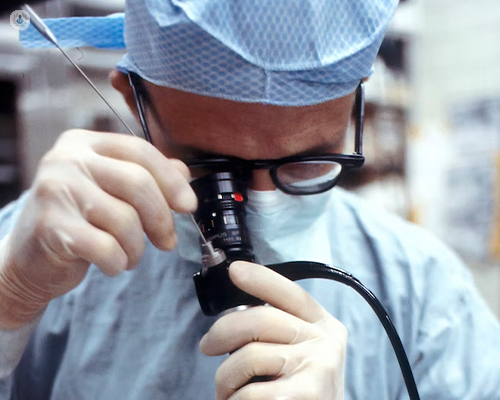A quick guide to MRI fusion prostate biopsy
Escrito por:An MRI fusion prostate biopsy is a medical procedure used to diagnose prostate cancer. It combines magnetic resonance imaging (MRI) with real-time ultrasound to improve the accuracy of prostate biopsies Leading consultant urologist Mr Andrew Ballaro explains all you need to know.

What is MRI fusion prostate biopsy and how does it work?
MRI fusion prostate biopsy is a new method of taking a tissue sample of the prostate gland for analysis. This is usually required when an MRI scan of the prostate has shown a suspicious or abnormal area which we don’t know whether is prostate cancer or inflammation.
Software enables the diagnostic MRI images, with the area of concern digitally marked, to be adjusted to size and superimposed onto the ultrasound images of the prostate we generate in real-time during the biopsy process and this facilitates precise placement of the sampling biopsy needles into the exact area of the prostate requiring biopsy only and not into surrounding normal prostate tissue.
What is MRI fusion prostate biopsy and how does it work?
Traditional prostate biopsy used to be done using transrectal route putting the needle into the prostate via the rectum. This has largely been abandoned in favour of transperineal biopsies which involves the needles placed through the skin of the perineum as this has a much lower risk of infection.
With standard transperinal biopsies, the prostate gland is imaged by an ultrasound probe placed in the rectum, and the needles placed in the area of the prostate thought to be requiring biopsy. With this technique however, the actual area of concern in the prostate is not apparent on the ultrasound images as their resolution is not high enough to visualise possible tumour, we can only estimate where the area is based on the written report of the MRI scans.
How does MRI fusion biopsy compare to traditional prostate biopsy methods?
In large prostates, this often means taking large numbers of biopsies in the hope of sampling the abnormal area. This risks missing a tumour, particularly if the area is small relative to the prostate, and higher complications and discomfort resulting from the larger numbers of biopsies. With MRI fusion biopsy we can confidently place the biopsy needles into the area of concern and this minimises complications and the risk of a tumour being missed.
What are the benefits of undergoing an MRI fusion prostate biopsy?
With MRI fusion biopsy we can confidently place the biopsy needles into the area of concern and this minimises complications and the risk of a tumour being missed.
Benefits are as above, a potential prostate cancer can be accurately biopsied minimising complications. With MRI fusion biopsy we can confidently place the biopsy needles into the area of concern and this minimises complications and the risk of a tumour being missed.
Are there any risks or side effects associated with MRI fusion prostate biopsy?
The risks of MRI fusion biopsy are far less than standard biopsy techniques. They occasionally do happen though and include blood in the urine and sperm, perineal bruising and discomfort and, rarely, difficulty in passing urine after.
What should I expect during and after an MRI fusion prostate biopsy procedure?
The procedure is done as a day case under a short general anaesthetic and takes about 30 minutes. The patient walks out of hospital a few hours afterwards and the histology is ready in a few days.
If you would like to book a consultation with Mr Ballaro, do not hesitate to do so by visiting his Top Doctors profile today.


